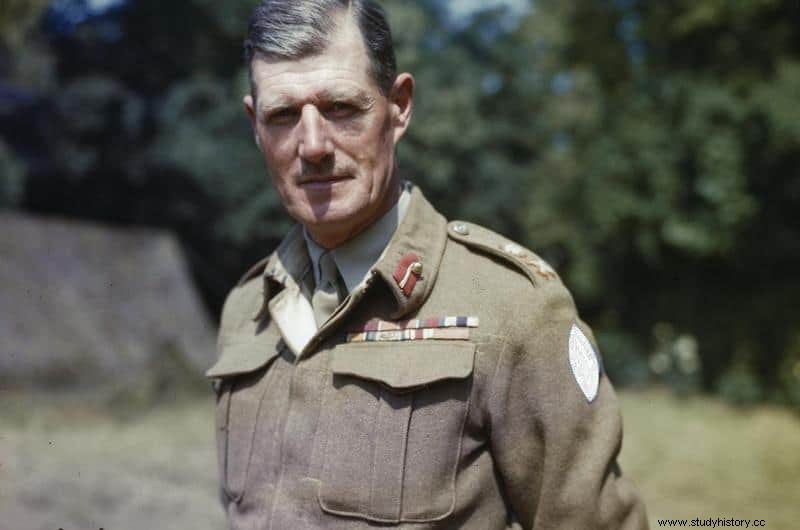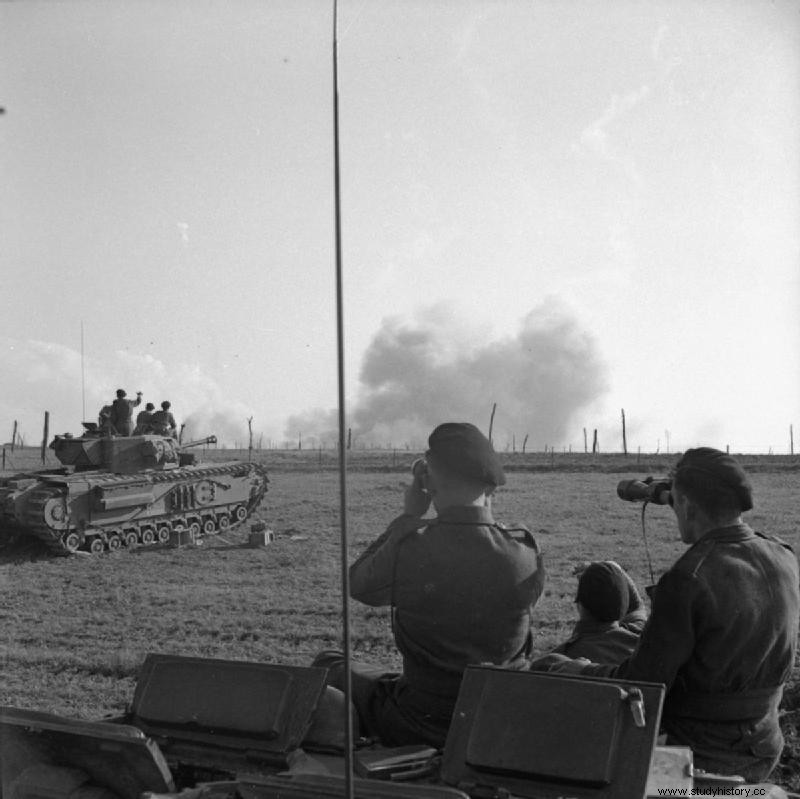Le Havre was a headache for the Allies' strategy, because it was located in the rear and on the flanks of their armies at the same time. The British decided to force the surrender of the German garrison.
General Crocker arrived at Le Havre with orders to quickly seize the port, although he had a limited means of ground troops. Opposite him was the German Colonel Wildermuth, a fervent German nationalist. However, the commander of a garrison was required to swear to Hitler that he would hold out as long as he had men left.
The road to Le Havre
Allied troops had just set foot on the beaches of Normandy. In mid-July 1944, hundreds of men were facing the Germans, who were trying to resist the steamroller. They fought in the fields and in the Norman cities. Rouen, Cherbourg and Caen fell after fighting that caused the death of thousands of civilians and soldiers.
Everything was happening too fast. To such an extent that many strategists thought they would win the war before the end of 1944. But the Allied advance was so rapid that supply problems soon arose. Out of fuel, General George Patton's tanks stopped dead on the shoulders of French roads.
The allied commander needs new bases on the Norman coast where the supply will transit. The chosen place was the port of Le Havre. A decision that would have fatal consequences for the city.
The person in charge of liberating Le Havre was General John Crocker. Nicknamed "Honest John" for his deep religious convictions and moral integrity. Taciturn and discreet, he was the polar opposite of arrogant generals like Patton or Montgomery. He had been decorated for his heroic deeds during the first world war.
In 1940 he was considered one of the best strategists in the use of battle tanks. In the summer of 1944 Montgomery entrusted him with the taking of Caen. The conquest of the Norman city was endless. The battle was announced quickly, however, it took six weeks and up to four offensives to conquer the city. Crocker lost 3,500 men.
Festung Le Havre
When General Cocker was entrusted with taking the port of Le Havre, it was envisaged as a quick and easy conquest, for which limited material means were allocated. However, the port of Le Havre had become a Festung , a highly fortified city, part of the Atlantic Wall of Nazi Germany.

The city was defended by a large amount of heavy artillery and a garrison of thousands of soldiers. In command, Major Hermann Wildermuth, a former banker and politician, sympathizer with the Nazi regime since the mid-1930s. Wildermuth was a colonel with combat experience. He had excelled in the rapid Yugoslav campaign of 1940.
His diligent and highly effective military behavior did not go unnoticed during the war. Hitler placed him in command of the Le Havre garrison in July 1944, with orders to destroy the port and hold the fortress at any cost.
To fulfill the oath made to the Führer of Nazi Germany and fight to the death, Colonel Wildermuth had a garrison of 12,000 men, who were specially trained for the combat that awaited them.
From Vichy and Allied propaganda, the inhabitants of Le Havre knew that the Allies had been in France since June 6. But in the city nothing had changed. The Havreses were still under the German yoke, which showed no sign of weakness.
The bombing of June 12
On June 12, 1944, Le Havre was bombed by the British Air Force. It was not the first time that the allies had bombed this German stronghold, but never with such intensity.
The harbor basins, where several German destroyers and submarines were moored, were hit. The German navy suffered considerable damage, but the hardest hit was the urban area, where rubble had to be removed for days and the bodies of civilians killed by the bombing had to be buried.
But what was the objective of the June bombing? Were the allies preparing an imminent landing at Le Havre? In reality, the June bombardment had a purely military objective:the base to anchor fast torpedo boats. These German speedboats had harassed the English navy since 1940 in the channel. They were seen as a serious threat to allied transport vessels, so their destruction was a priority.

The British destroyed the German naval base. Later, the same Germans sabotaged the port throughout the summer to prevent the Allies from using it. The bombardments caused the flight of a part of the population. The city had 150,000 inhabitants. It is estimated that at this time the population fell to 50,000 inhabitants.
The assault preparation
During the summer and despite increasing supply problems, the allies continued their advance. They liberated Paris to jubilation on August 26, 1944. Le Havre remained a priority. The city was already completely surrounded by British troops.
On Sunday, September 3, 1944, a crucial meeting was held at the headquarters of the British 1st Army north of Le Havre. General Crocker assembled British and Canadian officers to prepare for the attack. He only had two divisions to take over the city.

Crocker was aware that assault by sea was impossible because the beach defenses were relatively strong. He knew, as did Wildermuth, that the offensive would have to come primarily from the north and northeast, preceded by a massive bombardment.
Bombing seemed to be the perfect strategy. It avoided direct intervention and would put fear into the body of the Germans. All the information indicated that they were at the limit. With luck, the mere threat of bombing would be enough to bring them to their knees.
The British had a map of the city drawn by members of the French resistance detailing the enemy defense system. It represented a very well defended city. Fortifications and artillery batteries to the west. Pits and minefields to the east. In total 77,000 mines and 430 bunkers.
But there were some mistakes. Intelligence services estimated that the garrison numbered 8,000 men. Actually, it was 12,000.
